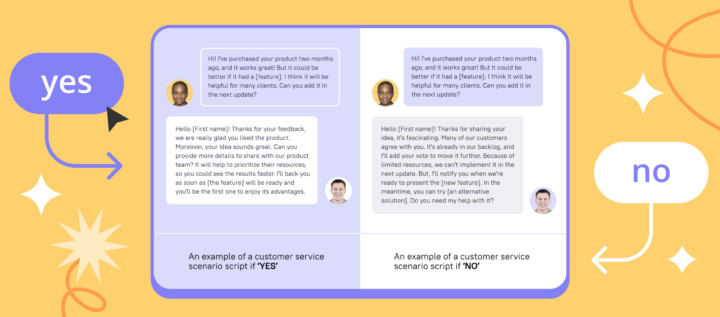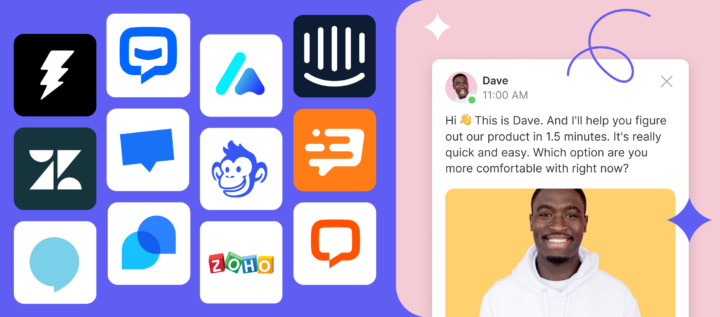‘Everything Around Us Is a Product,’ — Says Nika, Product Heroes Course Ex-producer

Dashly chatbot platform team had a conversation with Nika, UNCRN.me co-founder and ex-CEO, IIDF tracker.
We’ve talked about:
- what kind of researches help products to grow,
- what mistakes are the most common when conducting research,
- how the research process works in startups and enterprises,
- what is a product management CJM and how to make it better.
— Do you think researches are in demand in the product management sphere?
I see that many product managers want to improve their product development process, especially the research process. All the companies I’m talking to are craving something new, expecting changes, and improving their product. This is why I’m convinced that researchers are really in demand. But the survivorship bias may appear there, as guys who think that everything is fine rarely come to me.
— What types of researches are the most common?
To begin with, I’d divide all the researches into old school and modern ones. The first type is common in universities. All you need to do is to gather some people for a focus group, give them some money, and they will tell you what you want to hear from them. Everyone is happy, but you won’t get any significant data.
If we look at the bigger picture, we can divide all the researches into two types. The first ones are used correctly, in the appropriate period of time and product development stage, and the second ones are used incorrectly (e.g., A/B tests conducted on five users).
Let’s consider a situation. You’ve got two interface options. There is a difference between them, and both of them were hallway tested. But this difference between them is insignificant if there are dozens of thousands of people. ‘But what if we take millions of people? ’ — say guys in Google and start testing. This is an exception, as most companies don’t have such a number of users. However, companies with five users often start doing A/B testing and get upset when they don’t see any result.
Read also: how to find respondents for a survey or customer interview
— It seems like product-first companies mostly prefer qualitative than quantitative research. Is this true?
Qualitative methods are suitable to use in the early stages of product development. That’s why startups often use this. Qualitative methods allow being fast and changing something quickly. Also, they enable being in touch with your users and being aware of their needs.
The advantage of the qualitative method is that you don’t need to count anything. Also, there is more information about them on the Internet. What’s more, the barrier to entry is lower. But qualitative researches still makes sense in some cases.
The more a product grows, the more need to use quantitative research. For example, Facebook conducts dozens of A/B-tests per day — they have enough product users for this.
In case a startup starts doing A/B tests on users of a parent company, the result will be irrelevant. In most cases, the team misses the problem and solution stage and starts testing a product-market fit. The problem remains outstanding, and the team gets disappointed. Experienced researchers know about this.
— Tell me how the research process looks like in companies you’ve worked with?
This depends on the company’s size.
Large companies usually have a research department. It seems cool, but actually, it works slowly. Often all the departments conduct researches by themselves because it’s faster than passing this task to the research department.
In this case, the quality problem appears. Often researchers don’t know some product nuances. But there may be a compromise: in some companies, the research team consists of guys from the product management team.
In startups and fast-growing teams, product marketing managers, and product managers take this task. Guys share all the information they find, and the outcome PMM has found out will also see a product manager. Sometimes designers, analysts, or even developers may take part in conducting researches. This is awesome, and I think it’s a must in all the companies that want to conduct research.
Companies where large-scale research is needed. Such companies often build their own processes. For example, they train junior product managers to conduct an interview. At the same time, researchers develop research guides and monitor the research quality, analysts collect data, and so on. They pass the outcome they’ve got to the product development team and propose the possible solution.
— Can you remember some interesting case studies connected with research?
I remember the team that’s set a goal to bring a new product into the market and earn $100 000 within three months. During the first week, they’ve conducted about 30-40 interviews. This allowed us to develop hypotheses that brought over 50% of the total revenue. There was still room to improve, but we left this for a second iteration.
— Can you remember some failures?
I remember guys who conducted focus groups. And their questions totally differed from what they researched. After this project was finished, they claimed that all the researches are useless.
Another case. A research team was assigned a big task. They should have conducted customer development interviews. Just in a week, they delivered a result and withdraws. But when they showed a document with respondents’ answers, there were only three user interviews.
And one more. In one month, the research team has conducted over 100 interviews. They were exhausted. They delivered outcomes on an entirely different topic. In the very beginning, they misunderstood the task and held user conversations on the wrong theme. And results were completely different from what was required. This was upsetting.
Read also:
Capture emails from website visitors with Pop-ups
Why user tracking on website is the best way to personalise your campaigns?
What is the best way to collect emails? 17 techniques Dashly clients use.
— In case there are too many research outcomes, is it essential to deliver outcomes to the whole team?
Firstly, it’s important to discuss the outcome inside the team. In case the research affects only the product development team decision, there is no need to deliver the results to the whole team. Also, this depends on the research scope, its importance, and so on.
— What types of research do you conduct inside your product?
We conduct hallway testings regularly. This happens when we launch a new course. But sometimes, there are periods when we shift the focus from courses and stop conducting hallway tests.
Over time, we’ve got people who we ask first. We select respondents that can pronounce all their actions and thoughts without starting to give their own opinion. These people give us the most valuable feedback. We appreciate it and ask them to give feedback first.
Simultaneously, we realize that all the people may become glassy-eyed if we show them the same thing every week. That’s why we have a list of people who we can ask for help in this situation.
— Are there any other tools that you’ll recommend using?
Mostly we use CJM, user research interviews, JTBD frameworks. There are lots of frameworks, tools, and skills. Even the ability to write a good title is a skill that you can upgrade. The ability not to tell the user what to do while interviewing a landing is a skill.
Read also:
- 10 best customer engagement strategies
- Client onboarding: how to engage, retain, and win users
- Customer engagement strategy: a complete guide to winning prospects in 2023
- What customer engagement platform is best for your business? 15 options to choose.
— Do you think it’s better to be good at one framework or continuously try to use new ones?
I always take into account the final goal and the person I talk to. We need to consider a person’s emotions, beliefs, and so on.
You can’t take a general set of frameworks and use it with a particular person. The result of this will be useless. It’s better to stay flexible and choose tools for a specific goal.
— In the Product Heroes course, I saw you’re talking about the product manager CJM and teaching how to build this. Could you tell me more about this?
When entering the office, people want to take off their outwear, drink some coffee, and so on. How would their journey look like to do this comfortably?
I think that everything around us is a product. For example, the office is a product as well, and this should be convenient for employees. Within this approach, a company hires not just an office manager but an office product manager. They should create employees CJM and make this as convenient as possible.
Product manager CJM is close to this. A product manager is an operation processes user. When creating this kind of CJM, we can find bottlenecks, generate a hypothesis, and achieve scalable growth.
Read more
- 10 Best Live Chat Software for Customer Support
- 10 Best Customer Service Chatbot Platforms to Level Up the Work
- How to create a user journey online map for your online school students [4 free templates]
- Increase Customer Support Efficiency With 15 Best Knowledge Base Tools
- Chatbot Guide: What can a chatbot do for your customers 24/7
— Do you think that everyone needs to do research?
You don’t always need to start your work from research. In many cases, you need to determine the problem first. You need to understand why a company stagnates. And only after formulating a problem, you may start conducting quantitative or qualitative research. The type of research depends on company size and the issue you work on.
— The last question for you. How to hack growth using research?
Qualitative researches are a growth hack by itself. Previously, many companies used to measure everything and tried to send much traffic on A/B tests. They spent a lot of money on this.
Now you can just find a few respondents, spend a couple of days on it, and get valuable insights that will lead you to significant changes. It’s very fast for large companies. I’m excited that companies use qualitative research more often than in the past; I always thought users have answers to all our questions.
Now you can just find a few respondents, spend a couple of days on it, and get valuable insights that will lead you to significant changes. It’s very fast for large companies. I’m excited that companies use qualitative research more often than in the past; I always thought users have answers to all our questions.
In case a company or a team is targeted on their customer happiness and valuable outcome, they will get it. In case the company’s only motivation is to implement their own ideas, they will probably realize it, too. But the problem is that it doesn’t mean that this will bring some value.
Read also:
- Attract customers with these 24 ecommerce lead magnets
- The 7 Key Email Marketing Metrics & KPIs You Should Be Tracking
- Product adoption: 7 tips to prove your value
We are working on a book on product research. Please take the servey if you’re a researcher, product manager, product marketer, or product designer. We’ll email you the book when it’s published. If you have research success stories or failures to share, text us via chat and we’ll add them to the book with a link to your product.
👉 How to use lead generation chatbot for your website
👉Lead nurturing platform for your revenue growth
👉 12 types of marketing nurture campaigns







